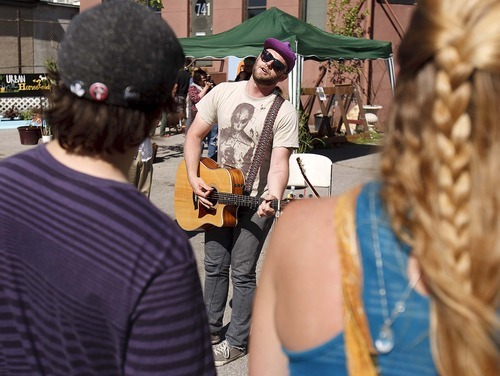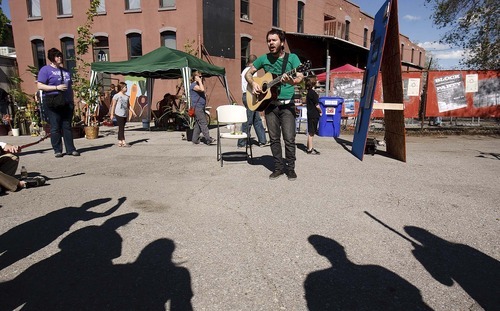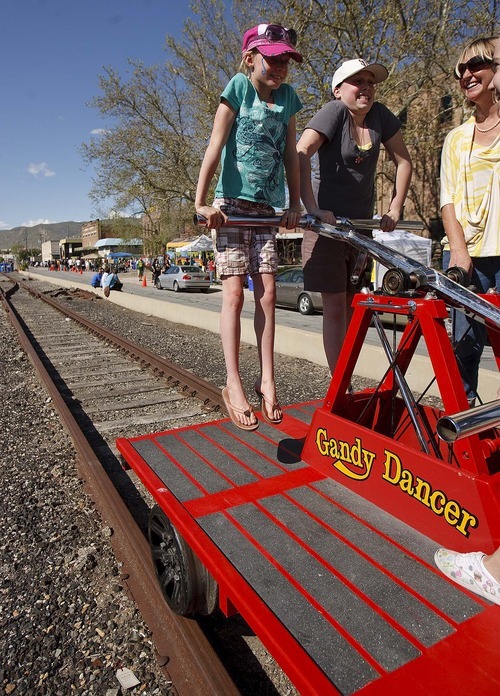This is an archived article that was published on sltrib.com in 2011, and information in the article may be outdated. It is provided only for personal research purposes and may not be reprinted.
As urban block parties go, it had all the accessories. Bands jammed, kids played, neighbors mingled and a healthy number of tattooed hipsters parked their fixed-gear bikes long enough Saturday to munch on sushi and plates from Frida Bistro.
But rather than the Avenues or Sugar House, this scene was wedged between warehouses — some distinctive, some derelict — on a patch of 400 West just south of downtown. And a closer look showed attendees mostly were artists — along with machinists, mechanics, glass-makers and other workers.
Collectively, this west Salt Lake City community is determined to shred the stereotype of the so-called "Granary District" as an industrial no-man's land. The area, roughly bounded by 600 and 900 South, 300 West and Interstate 15, is bubbling with eclectic spirit, advocates argue, and progressively planned potential.
Granary fans have more than wishful thinking to make their case. Modern Artspace units are filling up a half block from the beloved Pickle Company building near 800 South and 400 West. Artists have scratched out livelihoods in the defunct buildings, giving the area character and function. Planners are plotting a future 400 West streetcar to seam the moribund blocks to downtown. And city redevelopment bosses are targeting the hub for a residential-and-retail-fueled renaissance.
For Saturday's defiant band of budding urban planners, Granary's future is now.
Kristen McGrath, who grew up a few blocks away, said she remembers the district as pretty "crappy." But now, she has an artist boyfriend who works in the area and gets her body art from a Granary tattoo artist.
"Now that I'm older, I think it's pretty cool down here," McGrath said. "It could be the new Sugar House."
City officials and the most ardent Granary supporters say that kind of overhaul is a long way away. But pushing for more housing stock, lighting, and curb and gutter is an important start, they say.
"As a longtime Salt Lake City resident, I love that we've started to look further and further west to develop," said Salt Lake County Democratic Party Chairwoman Mary Bishop, a Liberty Park area resident who was at Saturday's block party. "I'm anxious and excited to see what they could do here — and what they can preserve."
The city is poised to pass a comprehensive Granary District development plan after months of study. Later this year, it will send out bid requests for projects mixing residential and retail use envisioned for 900 South. And the crown jewel remains the city's former fleet block (on 400 West between 800 and 900 South) as a blank slate expected to one day add an organic blend of housing, shopping and a park.
James Alfandre, a Washington, D.C., transplant who organized the block party, says he is hoping to create a market at Granary, followed by a full-fledged neighborhood.
"We want to show people what's possible down here," says Alfandre, praising the strip's "great bones" and ripe potential for "urban homesteading." "It's in such a great location, so close to downtown. It's just ready to grow."
New urbanists see an opportunity to reuse old buildings as increasingly popular live-work-play spaces. They are pushing for more meaningful investment, noting that with a TRAX station nearby, Granary fits Mayor Ralph Becker's definition of a transit-oriented development.
Some regulars remain skeptical.
"I don't think that it has much potential at all to be what they think," says Trent Call, an artist who has a studio near 500 West and 800 South, who worries about rising rents. He says Kilby Court and the recent addition of Frida Bistro have helped what is basically a "foundry."
"I've been in the neighborhood for 10 years and it's gotten a little more popular," Call says. "But I heard they're putting a streetcar in here and that seems kind of useless. This place is like a ghost town."
As an old fashioned hand-powered train cart glided across the center-street tracks — simulating a future streetcar — redevelopment agency vice chairman Carlton Christensen lauded the vision of Alfandre and Co.
"I've never seen anything that's been holistic like this," he says, "to get people to open your eyes to the possibilities and look past the broken sidewalks and rough roads."
Bill Davis, a veteran member of the Ballpark Community Council, says the area is perfectly positioned for a comeback.
"In 10 or 15 or 20 years, 1300 South is going to be the central boundary of the downtown business district," Davis says. "And everything is going to fill in in between. It can't, not happen."







